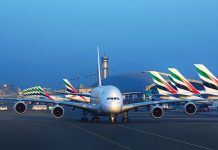Why do some airplanes when flying have blinking lights and other constant lights?
Every modern airliner is equipped with a comprehensive exterior illumination system that comprises of lights that blink, and lights that are constantly on.
The lights that flash are designed to attract attention, whereas the lights that are steadily on are mostly used for illumination purposes.
Let’s take a look at this Boeing 787 that has just left the runway after a nighttime landing: Well, the plane is barely visible. So, let’s turn some lights on. Firstly, we have the logo lights.

These lights are placed on the horizontal stabilisers, and they illuminate the airplane’s tail and the airline’s emblem, or acronym, in this case. They make the presence of the plane known in the dark.
A prominent, luminous vertical stabiliser decorated with an airline’s logo is a good indication that there’s an airliner nearby.
Next, we have the taxi lights: The taxi lights, found on the nose gear, illumine the taxiway ahead, making it visible for the pilots.
Following that, we have the landing lights and runway turnoff lights, both located near the wing root on the Dreamliner:
The landing lights are high beams that project light over long distances, making long stretches of the runway visible to the pilots.
Unlike the landing lights which shine straight forward, the runway turnoff lights are designed to irradiate the runway exits, which are diagonal to the runway, allowing the pilots to see in the dark while steering the aircraft towards an exit.
Hence, the runway turnoff lights are purposefully angled away from the centreline of the plane.

Note that some other airplane models, like the Airbus A350, have the runway turnoff lights on the nose gear, instead of the wing.
Okay, now the aircraft is quite noticeable on the ground. However, it can still be hard to spot the plane’s wings and fuselage, especially from a distance.
Therefore, we need the flashing lights. These lights are known as “anti-collision lights”, and the conspicuous blinking of the lights are easily perceived by the eye, even from afar.
There are two different sets of anti-collision lights implemented on modern airliners.
The first one is the white strobe lights: These high-intensity, glaring lights are the brightest lights on the airplane. They are located at each end of the wings, and flash at specific intervals.
If you are observant enough, you’ll notice that on Boeing airplanes, these strobe lights will blink once. On Airbuses, they will flash twice in rapid succession. That is because there is one strobe light on each wing of a Boeing plane, and two on every Airbus aircraft.
They are intended to attract the attention of pilots on other aircraft, so they’ll know to keep a safe distance. The lights are powerful enough to shine through fog or thick clouds in bad weather. So, the “blinking” you see in the night sky are usually an aircraft’s strobe lights.
This is how ridiculously bright the lights are: The white strobe lights are only turned on when the aircraft is near the runway, preparing to take-off, and they are deactivated once the plane exits the runway after a landing. This is done to avoid blinding the people in the airport terminal.
There is one more strobe light at the rear of the plane, near the APU exhaust. It blinks in unison with the other strobes.
The second anti-collision lighting system is the red coloured beacons that flash at the top and bottom of the fuselage:
In addition to alerting other pilots of the aircraft’s presence, the beacons help warn ground personnel that the plane’s engines are running, or that the engines are about to be started up, and so, the ground staff will know to stay clear of the aircraft.

The beacons are switched on once the airplane begins to reverse out of the gate, and they are only turned off after the plane has been parked at another gate and the engines have been shut off.
When all of the anti-collision lights are active, the white strobe lights and red beacons flash alternately, at a regular interval.
There is one specific set of lights that is constantly on but aren’t meant to be used as illumination. That will be the navigation lights. They come in three colours: red, green and white.
The red and green lights are situated at the front tip of the wings: The red light is always positioned on the port side (left) of the aircraft, while the green light is situated on the starboard side (right).

The white navigation lights are located at the tip of the trailing edges of each wing, and, at the rear end of the plane. (Do not confuse the aft navigation light with the aft strobe light. They are different.)
The navigation lights show the position and orientation of the aircraft. They will allow pilots and observers to determine the direction the airplane is facing.
If you happen to be seated beside a window near the wings on a night flight, this is what you might see outside: That steady glow of light is the plane’s white navigation light on the wingtip, as discussed previously.

The last set of lighting system equipped on an airliner is the engine/ wing inspection lights, installed on the fuselage of either side of the plane. The inspection lights illuminate the wings and engines, allowing the flight crew and maintenance personnel to check for any ice build-up, snow or damage on them, when necessary. The lights also improve visibility of the plane.
It is not mandatory for the inspection lights to be on during the flight, and the pilots can choose to keep them off for take-off and landing.
I know my answer is really long-winded, so I’ll summarise all the exterior lights on an airliner now.
Written By – Isaac Low, Quora’s big airplane fan.



















